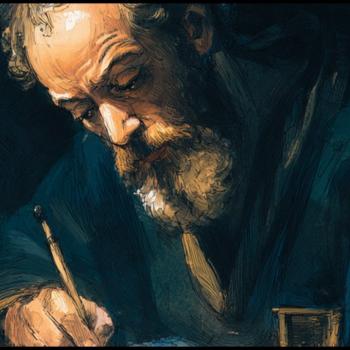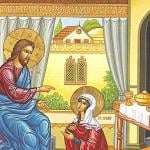
It’s always surprising to find something brand new in a verse you’ve read, and re-read, and studied, and re-studied dozens [if not thousands] of times before. But that’s exactly what happened a few days ago when I was looking at the Prodigal Son parable with a few students in my Square 2 course.
Here’s what happened: I was reading the parable from the Gospel of Luke and we were talking about how this famous illustration of the Father’s love actually comes after a series of two other parables on a similar theme. We also noted how the entire set of parables were originally told in answer to the question from the Pharisees about why Jesus always eats with sinners and tax collectors.
So, in context, Jesus tells all three of these parables – which are essentially re-tellings of the same parable three times – to illustrate WHY God spends time seeking after “sinners” [which is the key to understanding the twist ending in the prodigal son parable].
First, Jesus tells the story of how a “Good Shepherd” will leave the 99 in the fold to go and seek after the one sheep that was lost. Very simply, God is personified in the shepherd who seeks after the one who was lost [i.e. “the sinner”].
Next, Jesus tells a similar story of how a widow woman will light every lamp in her house and sweep it clean until she finds the one lost coin. Again, the idea is that God is personified in the widow who turns everything upside down to find what was lost [“the sinner” by analogy].
Finally, Jesus tells us the much longer story of the Father whose youngest son insults him, takes his inheritance, squanders it on debauchery, goes broke, feeds pigs and “comes to his senses” and decides to come home. Please note: This is all misdirection. We think that the “sinner” in this story is the young son. But we’re wrong. Because in this story the Father does not seek after the “sinner” as in the other two parables. Instead, in this story, the young son is the one who returns home on his own and it is the Father who eagerly rushes out to meet him on the way and restores him. That’s when we get to the actual “sinner” in the story when the Father goes outside the party to seek after the “lost son” [the older brother] who refuses to come inside the house.
Here is where Jesus turns the tables on the Pharisees who [like us] assumed the “sinner” in this parable was the younger son, but now they realize that the “sinner” whom the Father seeks after and goes out to find and restore is the older brother. This is when Jesus looks into the eyes of those Pharisees and lets them know that – even though they have separated themselves from the loving Father who loves and welcomes the people they see as “sinners,” the reality is that they are the ones the Father is going out to restore into the fold. They are the lost coin the widow sweeps the house to find. They are the older brother the Father leaves the party for, to bring back inside the house.
The message is clear: God is holding the door open for you. Come inside and enjoy the fellowship of the Father, and of those you have deemed unworthy of mercy. There’s still time for you to let go of your pride and to realize that “you are always with God, and all He has is yours.” All they have to do is recognize those “sinners” as “this brother [or sister] of yours.”
I must confess, I had never noticed this pattern before. But once I saw it [thank you Jordon Darling], it honestly gave me chills.
One other interesting pattern in that triad of parables is that Jesus personifies God in each of those parables as a Good Shepherd [the Son], a Widow [the Holy Spirit], and a loving Father [Abba Father]. Which means that God is revealed as both male and as female in the stories. [Let that one sink in if you need to].
Maybe you’ve already seen all of this in your own studies of this parable, but for me this was all brand-new. Hopefully it gives you a fresh perspective on the Father’s heart for us, and it teaches us to see who the real “sinners” are…and that it might be us if we’re the ones who refuse to see others as members of the Family of God.
**

Deconstruction isn’t easy. But you don’t have to go through it alone. Meet me at Square 1 on Feb. 8, 2021 for the 6th round of our 90-day online course and community. This is where you’ll connect with a dozen others who are asking the same questions you are. It’s also where you’ll discover practical answers and resources to help you develop a foundation for Reconstruction.
Register today for 65% off the regular price>
Keith Giles and his wife, Wendy, work with Peace Catalyst International to help build relationships between Christians and Muslims in El Paso, TX. Keith was formerly a licensed and ordained minister who walked away from organized church over a decade ago to start a home fellowship that gave away 100% of the offering to the poor in the community. Today he is the author of the best-selling “Jesus Un” series of books, including “Jesus Unexpected: Ending The End Times To Become The Second Coming” which is available now on Amazon.













